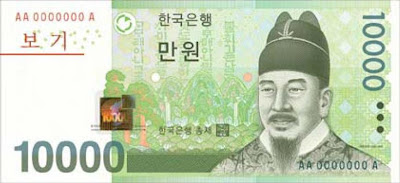 |
| King Sejong Jangheon Yeongmun Yemu Inseong Myeonghyo the Great |
He (Daniel, not the King) took his family to the King Sejong Museum in Seoul, Korea last month. He writes that the museum is located right across from the old capital complex and is very close to the U.S. Embassy there.
 |
| Daniel and Livia at the King Sejong Museum in Seoul |
The native phonetic alphabet system that King Sejong introduced, called Hangul, made it possible for anyone to easily learn to read and write. Up until the creation of Hangul, only members of the highest social class were literate, as writing required learning very complex characters based on classical Chinese characters.
 |
| Inside the museum |
King Sejong nurtured the introduction of a 28-letter Korean alphabet, first published in 1446, which changed his society forever. His goal was for Koreans from every class to learn to read and write. He also felt that, with a unique script, the Korean Language would provide the country with a cultural identity separate from their neighbors, China and Japan.
The new Hangul alphabet made it possible for anyone to learn to pronounce Korean script accurately after only a few hours of study, and be able to read and write in a matter of days.
Introducing Hangul had a big impact on Korean society.
 |
| The King Sejong Museum |
 |
| A 10,000 Korean Won Bill featuring King Sejong the Great |
King Sejong was a truly great man. It was fun to read about him. He had several wives and concubines and lots of children. He ascended to the throne in 1418, even though he was the third son of King Taejong. When he was a young prince he so excelled in various studies that his two older brothers made way for him to rule - the one becoming a wanderer, the other becoming a monk.
The King Sejong Museum looks like an interesting place to visit.
Thank you, Daniel, for sharing your experience there!

No comments:
Post a Comment